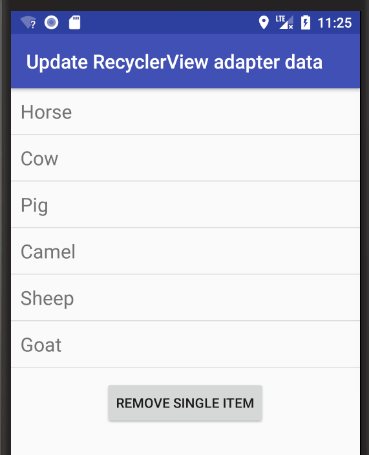A ViewHolder describes an item view and metadata about its place within the RecyclerView. RecyclerView. Adapter implementations should subclass ViewHolder and add fields for caching potentially expensive View. findViewById(int) results.
Today, suddenly Recyclerview. Viewholder became deprecated. Other, android project is no deprecated.
I have done something similar.
In your MyAdapter:
public class ViewHolder extends RecyclerView.ViewHolder implements View.OnClickListener{
public CardView mCardView;
public TextView mTextViewTitle;
public TextView mTextViewContent;
public ImageView mImageViewContentPic;
public ImageView imgViewRemoveIcon;
public ViewHolder(View v) {
super(v);
mCardView = (CardView) v.findViewById(R.id.card_view);
mTextViewTitle = (TextView) v.findViewById(R.id.item_title);
mTextViewContent = (TextView) v.findViewById(R.id.item_content);
mImageViewContentPic = (ImageView) v.findViewById(R.id.item_content_pic);
//......
imgViewRemoveIcon = (ImageView) v.findViewById(R.id.remove_icon);
mTextViewContent.setOnClickListener(this);
imgViewRemoveIcon.setOnClickListener(this);
v.setOnClickListener(this);
mTextViewContent.setOnLongClickListener(new View.OnLongClickListener() {
@Override
public boolean onLongClick(View view) {
if (mItemClickListener != null) {
mItemClickListener.onItemClick(view, getPosition());
}
return false;
}
});
}
@Override
public void onClick(View v) {
//Log.d("View: ", v.toString());
//Toast.makeText(v.getContext(), mTextViewTitle.getText() + " position = " + getPosition(), Toast.LENGTH_SHORT).show();
if(v.equals(imgViewRemoveIcon)){
removeAt(getPosition());
}else if (mItemClickListener != null) {
mItemClickListener.onItemClick(v, getPosition());
}
}
}
public void setOnItemClickListener(final OnItemClickListener mItemClickListener) {
this.mItemClickListener = mItemClickListener;
}
public void removeAt(int position) {
mDataset.remove(position);
notifyItemRemoved(position);
notifyItemRangeChanged(position, mDataSet.size());
}
Hope this helps.
Edit:
getPosition() is deprecated now, use getAdapterPosition() instead.
first of all, item should be removed from the list!
mDataSet.remove(getAdapterPosition());
then:
notifyItemRemoved(getAdapterPosition());
notifyItemRangeChanged(getAdapterPosition(),mDataSet.size());
if still item not removed use this magic method :)
private void deleteItem(int position) {
mDataSet.remove(position);
notifyItemRemoved(position);
notifyItemRangeChanged(position, mDataSet.size());
holder.itemView.setVisibility(View.GONE);
}
Kotlin version
private fun deleteItem(position: Int) {
mDataSet.removeAt(position)
notifyItemRemoved(position)
notifyItemRangeChanged(position, mDataSet.size)
holder.itemView.visibility = View.GONE
}
RecyclerView was built to display data in an efficient and responsive manner.
Usually you have a dataset which is passed to your adapter and is looped through to display your data.
Here your dataset is:
private ArrayList<String> mDataset;
The point is that RecyclerView is not connected to your dataset, and therefore is unaware of your dataset changes.
It just reads data once and displays it through your ViewHolder, but a change to your dataset will not propagate to your UI.
This means that whenever you make a deletion/addition on your data list, those changes won't be reflected to your RecyclerView directly. (i.e. you remove the item at index 5, but the 6th element remains in your recycler view).
RecyclerView exposes some methods for you to communicate your dataset changes, reflecting those changes directly on your list items.
The standard Android APIs allow you to bind the process of data removal (for the purpose of the question) with the process of View removal.
The methods we are talking about are:
notifyItemChanged(index: Int)
notifyItemInserted(index: Int)
notifyItemRemoved(index: Int)
notifyItemRangeChanged(startPosition: Int, itemCount: Int)
notifyItemRangeInserted(startPosition: Int, itemCount: Int)
notifyItemRangeRemoved(startPosition: Int, itemCount: Int)
If you don't properly specify what happens on each addition, change or removal of items, RecyclerView list items are animated unresponsively because of a lack of information about how to move the different views around the list.
The following code will allow RecyclerView to precisely play the animation with regards to the view that is being removed (And as a side note, it fixes any IndexOutOfBoundExceptions, marked by the stacktrace as "data inconsistency").
void remove(position: Int) {
dataset.removeAt(position)
notifyItemChanged(position)
notifyItemRangeRemoved(position, 1)
}
Under the hood, if we look into RecyclerView we can find documentation explaining that the second parameter we pass to notifyItemRangeRemoved is the number of items that are removed from the dataset, not the total number of items (As wrongly reported in some others information sources).
/**
* Notify any registered observers that the <code>itemCount</code> items previously
* located at <code>positionStart</code> have been removed from the data set. The items
* previously located at and after <code>positionStart + itemCount</code> may now be found
* at <code>oldPosition - itemCount</code>.
*
* <p>This is a structural change event. Representations of other existing items in the data
* set are still considered up to date and will not be rebound, though their positions
* may be altered.</p>
*
* @param positionStart Previous position of the first item that was removed
* @param itemCount Number of items removed from the data set
*/
public final void notifyItemRangeRemoved(int positionStart, int itemCount) {
mObservable.notifyItemRangeRemoved(positionStart, itemCount);
}
You can let a library like FastAdapter, Epoxy or Groupie take care of the business, and even use an observable recycler view with data binding.
Google recently introduced a new way of writing the recycler view adapter, which works really well and supports reactive data.
It is a new approach and requires a bit of refactoring, but it is 100% worth switching to it, as it makes everything smoother.
here is the documentation, and here a medium article explaining it
Here are some visual supplemental examples. See my fuller answer for examples of adding and removing a range.
Add "Pig" at index 2.

String item = "Pig";
int insertIndex = 2;
data.add(insertIndex, item);
adapter.notifyItemInserted(insertIndex);
Remove "Pig" from the list.

int removeIndex = 2;
data.remove(removeIndex);
adapter.notifyItemRemoved(removeIndex);
If you love us? You can donate to us via Paypal or buy me a coffee so we can maintain and grow! Thank you!
Donate Us With